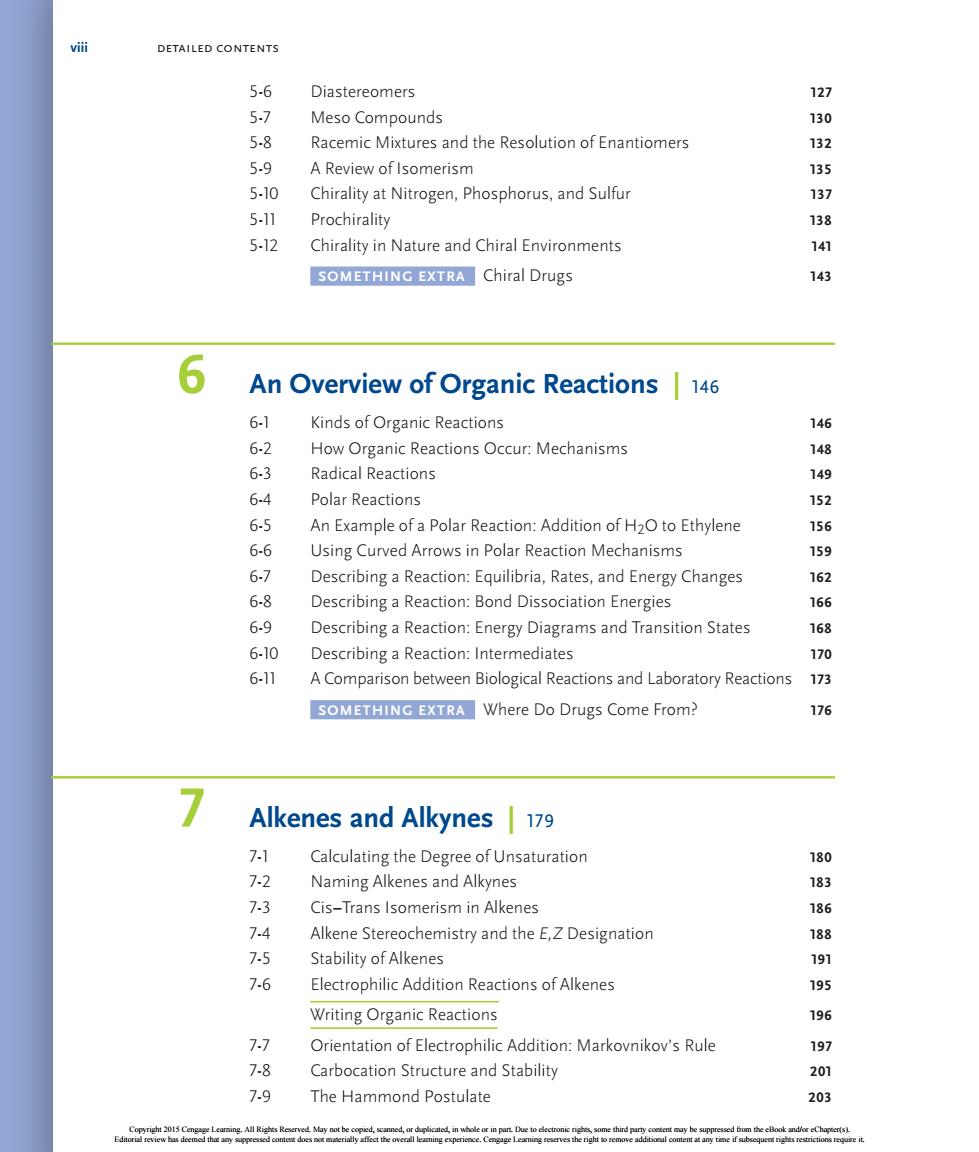正在加载图片...

DETAILED CONTENTS 5.6 Diastereomers 5.) Meso Compounds 1 5-8 Racemic Mixtures and the Resolution of Enantiomers 132 5-9 A Review of Isomerism 5-10 Chirality at Nitrogen,Phosphorus,and Sulfur 13 5-11 Prochirality 38 5-12 Chirality in Nature and Chiral Environments 14 SOMETHING EXTRA Chiral Drugs An Overview of Organic Reactions 146 6-1 Kinds of Organic Reactions 146 6-2 How Organic Reactions Occur:Mechanisms 148 63 Radical reactions 6 Polar Reactions 2 65 An Example of a Polar Reaction:Addition of H2O to Ethylene 6-6 Using Curved Arrows in Polar Reaction Mechanisms 159 6-7 Describing a Reaction:Equilibria,Rates,and Energy Changes 162 6-8 Describing a Reaction:Bond Dissociation Energies 6-9 Describing a Reaction:Energy Diagrams and Transition States 68 6-10 Describing a Reaction:Intermediates 170 6-11 A Comparison between Biological Reactions and Laboratory Reactions SOMETHING EXTRA Where Do Drugs Come From? 176 Alkenes and Alkynes 179 7-1 Calculating the Degree of Unsaturation 72 180 Naming Alkenes and Alkynes 1 7-3 Cis-Trans Isomerism in Alkenes 186 Alkene Stereochemistry and the E.Z Designation 7-5 Stability of Alkenes 189 7-6 Electrophilic Addition Reactions of Alkene 195 Writing Organic Reactions 196 77 Orientation of Electrophilic Addition:Markovnikov's Rule 91 7-8 Carbocation Structure and Stability 7-9 The Hammond Postulate 203 viii DetaileD Contents 5-6 Diastereomers 127 5-7 Meso compounds 130 5-8 Racemic Mixtures and the Resolution of Enantiomers 132 5-9 a Review of isomerism 135 5-10 chirality at nitrogen, phosphorus, and sulfur 137 5-11 prochirality 138 5-12 chirality in nature and chiral Environments 141 soMetHinG eXtra chiral Drugs 143 6 an overview of organic reactions | 146 6-1 Kinds of organic Reactions 146 6-2 how organic Reactions occur: Mechanisms 148 6-3 Radical Reactions 149 6-4 polar Reactions 152 6-5 an Example of a polar Reaction: addition of h2o to Ethylene 156 6-6 Using curved arrows in polar Reaction Mechanisms 159 6-7 Describing a Reaction: Equilibria, Rates, and Energy changes 162 6-8 Describing a Reaction: Bond Dissociation Energies 166 6-9 Describing a Reaction: Energy Diagrams and transition states 168 6-10 Describing a Reaction: intermediates 170 6-11 a comparison between Biological Reactions and laboratory Reactions 173 soMetHinG eXtra where Do Drugs come From? 176 7 alkenes and alkynes | 179 7-1 calculating the Degree of Unsaturation 180 7-2 naming alkenes and alkynes 183 7-3 cis–trans isomerism in alkenes 186 7-4 alkene stereochemistry and the E,Z Designation 188 7-5 stability of alkenes 191 7-6 Electrophilic addition Reactions of alkenes 195 writing organic Reactions 196 7-7 orientation of Electrophilic addition: Markovnikov’s Rule 197 7-8 carbocation structure and stability 201 7-9 the hammond postulate 203 42912_00_FM_i-xxiv.indd 8 1/16/14 3:00 PM Copyright 2015 Cengage Learning. All Rights Reserved. May not be copied, scanned, or duplicated, in whole or in part. Due to electronic rights, some third party content may be suppressed from the eBook and/or eChapter(s). Editorial review has deemed that any suppressed content does not materially affect the overall learning experience. Cengage Learning reserves the right to remove additional content at any time if subsequent rights restrictions require it